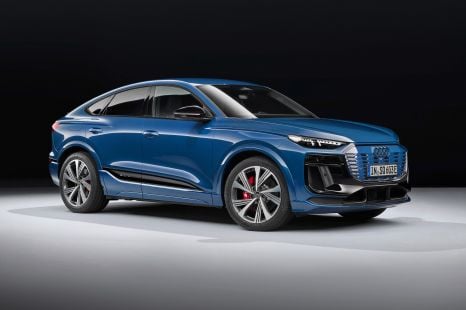

William Stopford
2026 Audi Q6 and SQ6 Sportback e-tron price and specs
2 Days Ago
It may be getting on a bit, but there's still a lot to like about the RX350L Sports Luxury. Can it still compete with the Germans though?



Marketplace Editor
New from
$73,013
excl. on-roads

Marketplace Editor
New from
$73,013
excl. on-roads


Marketplace Editor
New from
$73,013
excl. on-roads

Marketplace Editor
New from
$73,013
excl. on-roads
Quickly see how this car stacks up against its competition. Select any benchmark to see more details.
Where expert car reviews meet expert car buying – CarExpert gives you trusted advice, personalised service and real savings on your next new car.
The Lexus RX nameplate dates back to the late 1990s in some markets, and the badge has been doing the rounds in Australia since the early 2000s.
Fast forward to the end of 2017 and the luxury arm of Toyota decided to have a real crack at the likes of the Audi Q7, BMW X5 and Mercedes-Benz GLE with the RX L, a five-metre-long, three-row version of its long-running and top-selling nameplate.
While rivals are constantly trying to outdo each other with dazzling in-car displays and flash semi-autonomous driving systems, the Lexus stays true to its roots with bulletproof build quality, simple and conventional driver controls, and a solid feelingthat lends a sense of safety and security on the road.
Sure, it’s getting on a bit and an all-new model is expected in the next 12-18 months, but does that mean you should overlook what’s on sale now?
Here on test we have the 2022 Lexus RX350L Sports Luxury, the flagship trim featuring a silky-smooth naturally-aspirated V6 propulsion. If you’re the kind to say “they don’t make cars like they used to”, this could be what you’re looking for.

The Lexus RX350L Sports Luxury we have on test lists for $103,713 before on-road costs, working out to a little over $115,600 drive-away using a Melbourne postcode.
See the full price list below:
All prices exclude on-road costs
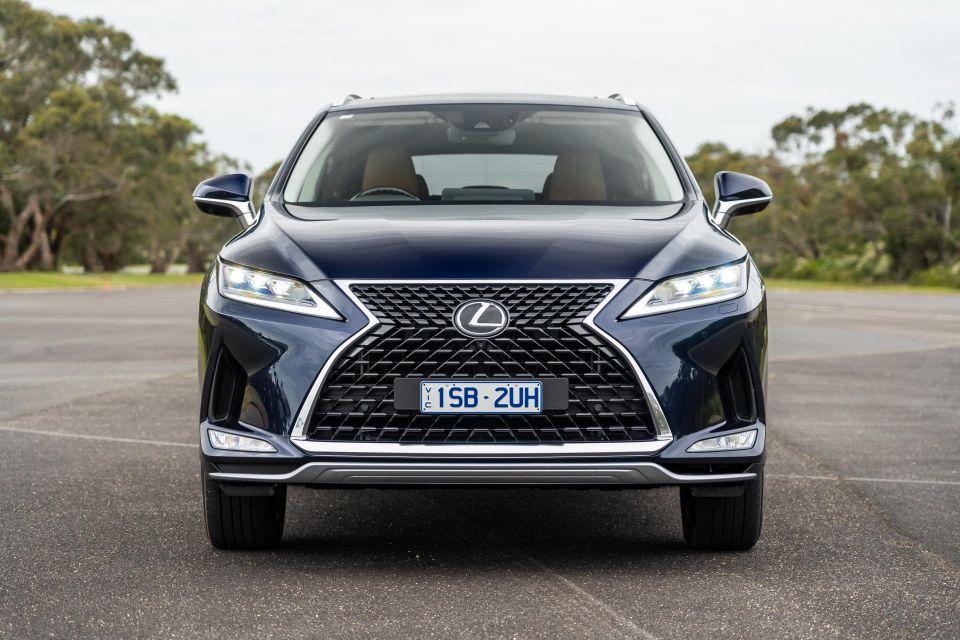
While six figures for any family car is a lot of cash, the top-spec RX L is decent value among its key rivals, positioning itself against entry-level or mid-spec versions of competing nameplates, and not demanding buyers tick any options boxes.
The standard inclusion of seven seats (we’ll assess their effectiveness later) is also a point of difference against the Germans bar the Audi Q7.
The Genesis GV80 is probably the RX L’s closest rival, offering similarly distinctive design and interior packaging with a layer of plushness and technology.
Key rivals include:
All prices exclude on-road costs
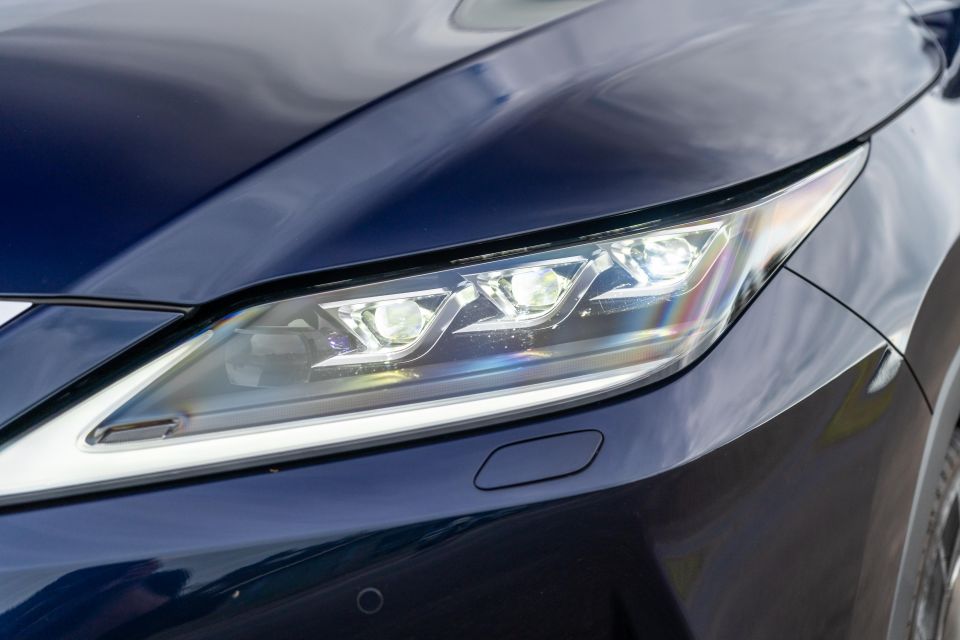


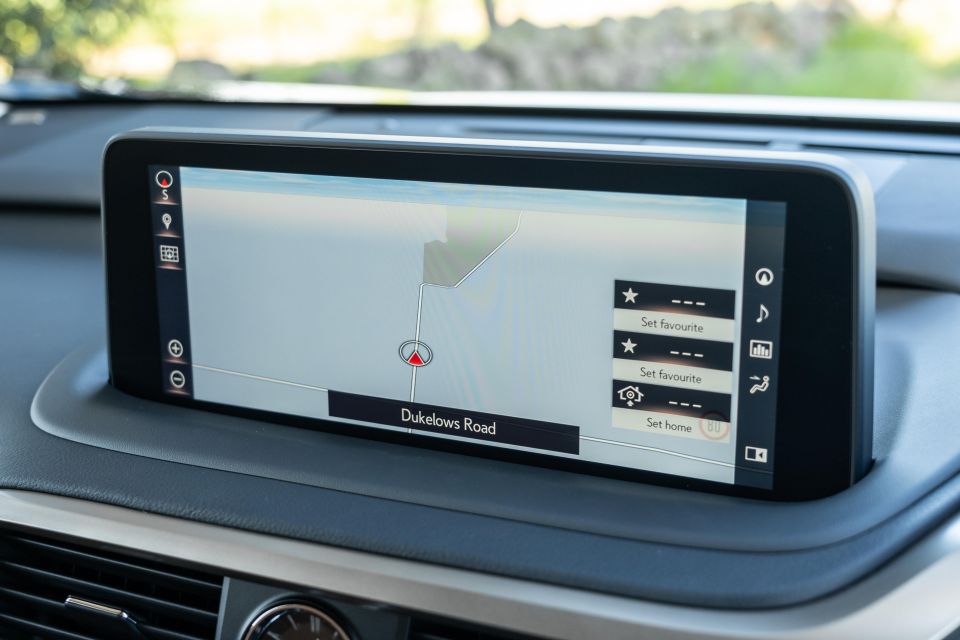
Buy your new car without the stress. It's fast, simple and completely free.

Great service from Travis and team, second time I have used this business would not hesitate to recommend them to anyone
Craig C.
Purchased a Ford Ranger in Sunshine Coast, QLD
CarExpert helped Craig save $7,224 on his Ford Ranger, now let us save you on your next new car.
Get your BEST priceRX Sports Luxury models score the following exclusive equipment:
That’s on top of kit from F Sport and Luxury grades, including:
Being the extended L version, the RX on test also scores a power-folding third row of seating with separate climate controls, though the panoramic glass sunroof in five-seat models is swapped out for a front moonroof.
Some equipment omissions show the vehicle’s age, such as the lack of a digital instrument cluster (five-seat RX F Sport models get an 8.0-inch part-digital cluster) or air suspension.
Having the standard head-up display in the Sports Luxury brings a digital speedometer, though the supervision cluster between the analogue dials lacks a speedo readout. The clunky maze-like gearshift also harks back to a different time.
The atmo V6 and lack of fuel-saving stop/start technology also add to this, but we’ll cover the powertrain in better detail later.
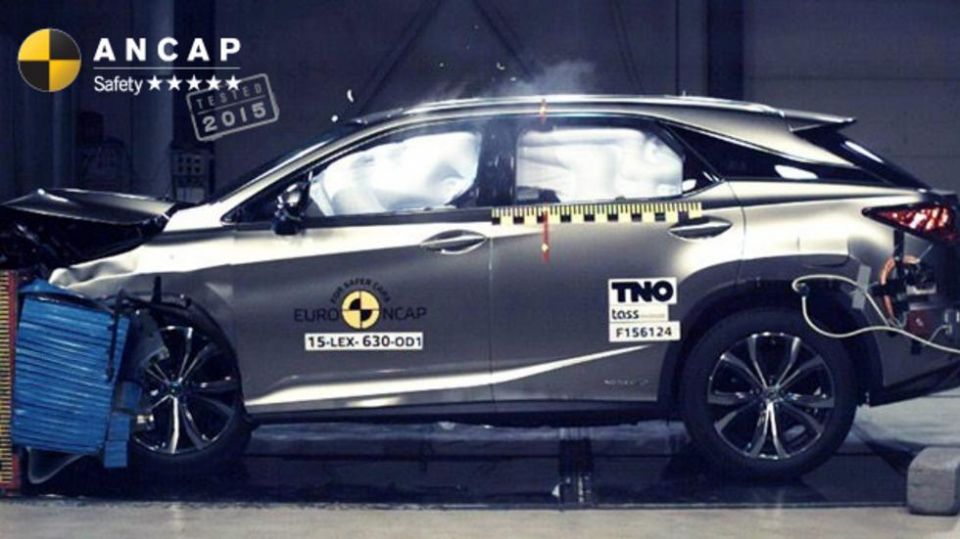
All members of the RX range were given a five-star ANCAP rating in 2015 on the back of Euro NCAP testing.
The range received an adult occupant protection score of 83 per cent (despite a 0.0 from 3 result for AEB City), 82 per cent for child occupant protection, 79 per cent for pedestrian protection and 74 per cent for safety assist (with 0.0 out of 3 for speed assistance system).
Standard assistance equipment includes:
There’s also a nifty Drive Start Control that reduces power if you grab the wrong transmission drive mode (for example, Drive to Reverse).
The 10-airbag suite encompasses dual front, driver’s knee, front passenger cushion, as well as dual side and curtain coverage for the first and second rows.
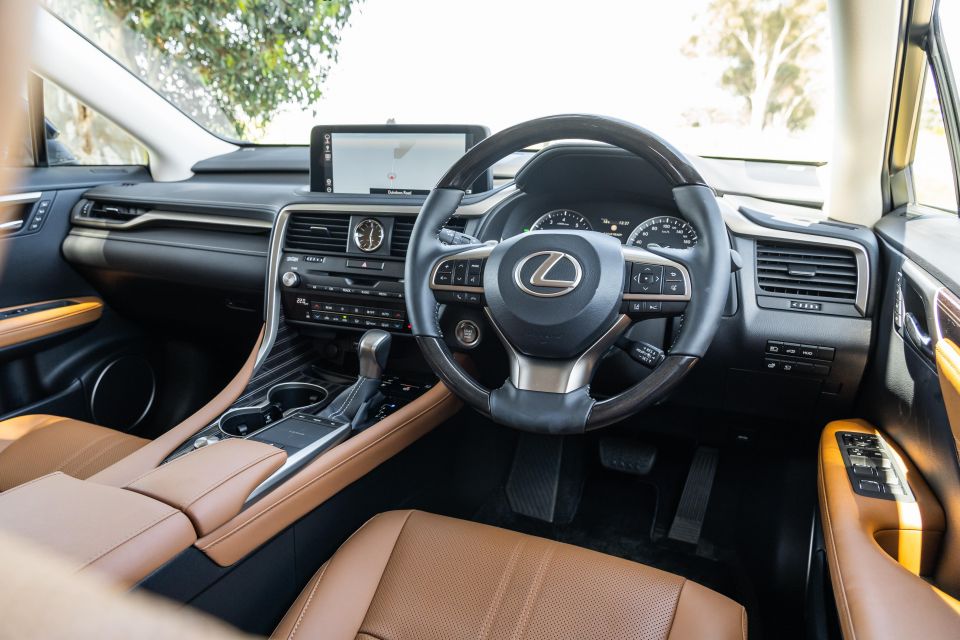
Hopping into the cabin of the RX is like stepping back in time when you consider most European rivals are going all out on flashy displays and touch-capacitive controls. That’s not to say it’s a bad thing, though.
Our tester’s ‘Ochre’ tan-coloured semi-aniline leather interior with laser-cut wood inserts felt old-school but equally sumptuous. It feels like a luxury bank vault.
The seats are super comfortable, the touch points all wonderfully finished, the electrically-adjustable steering wheel and seats are smooth and quiet in operation. It’s just a really nice place to sit.
Sure, the matte black plastic on the centre stack with its myriad switches is a throwback, as are the analogue clock between the vents and the CD player sat in the centre of the dash, but everything is functional, logically laid out, and feels solid in operation.
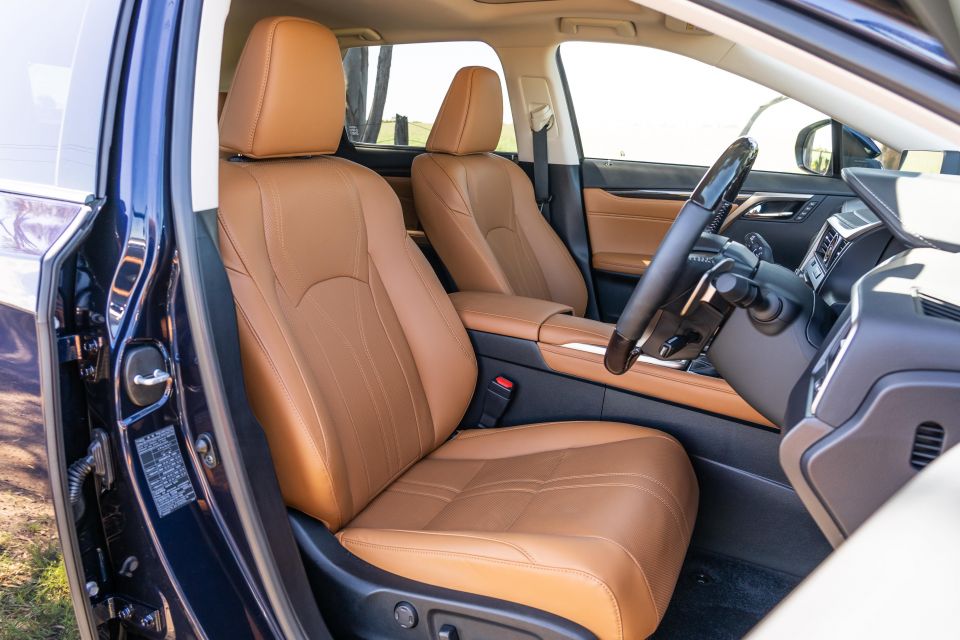
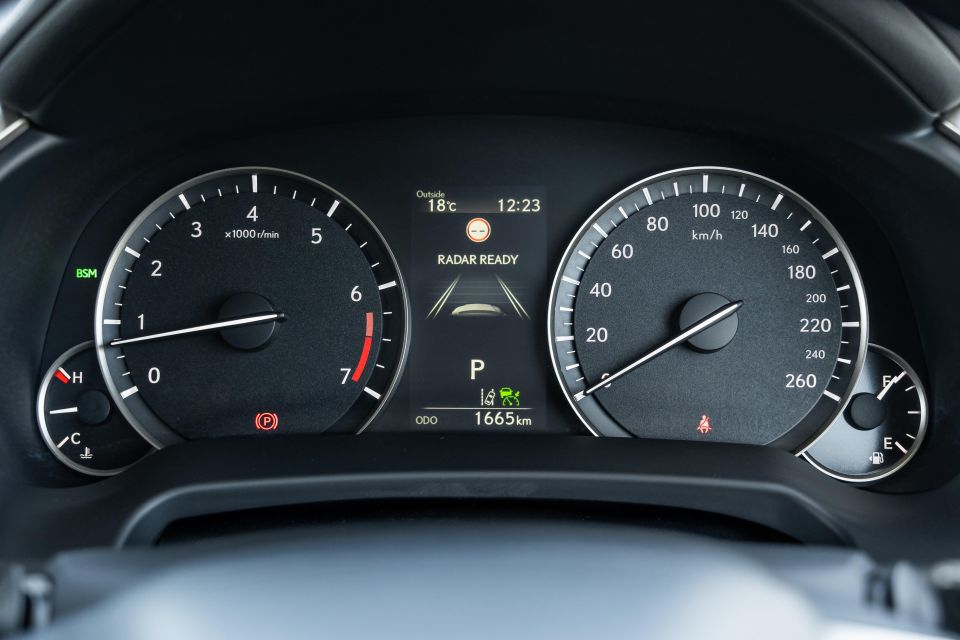
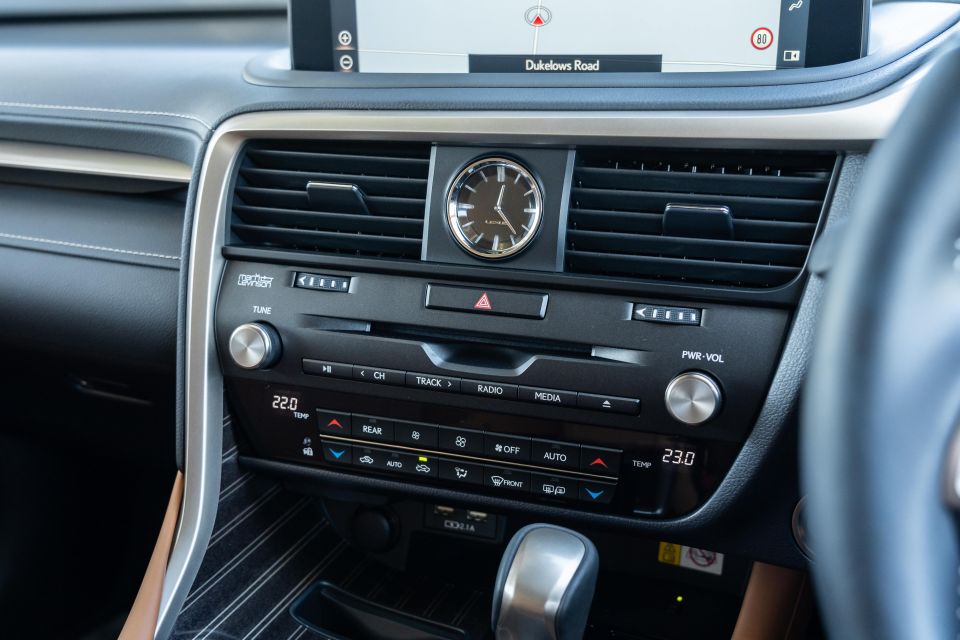
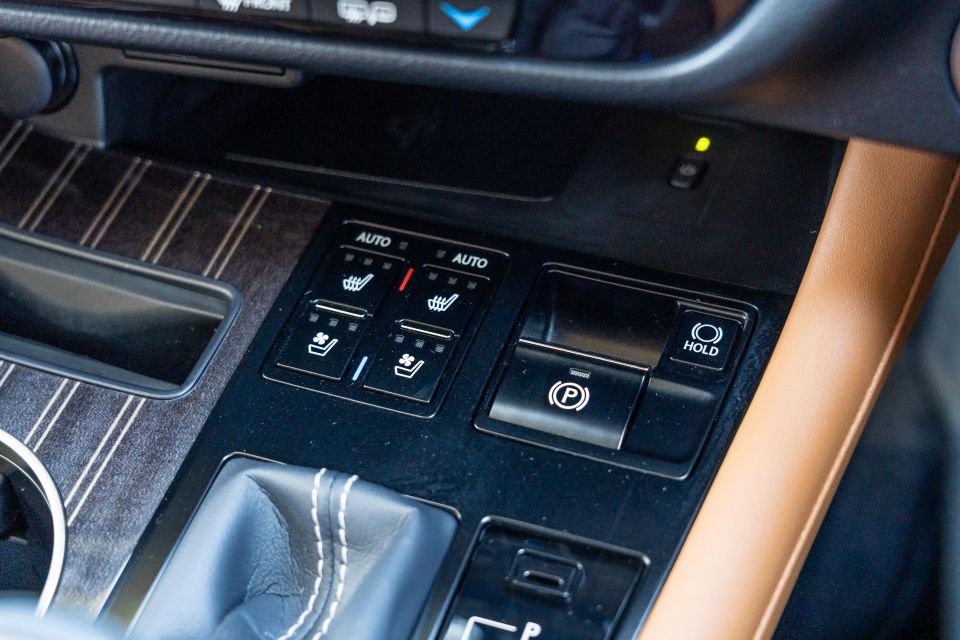
Ahead of the driver is a clean analogue instrument binnacle with conventional speedo and tacho dials, with a TFT supervision display nestled between. While I won’t necessarily knock the RX L for not offering a digital cluster like five-seat F Sport models, I will dock points for the trip computer display not having a digital speed readout, as well as really archaic menus and graphics from the previous generation of Toyota products.
Luckily, there’s a colour head-up display projecting a digital speedometer and rev counter into the driver’s line of sight, and there’s a couple of different layouts to suit your tastes.
Comfort and space is good up front, with heaps of electric adjustment in the seats and steering wheel – including memory – and there’s numerous nooks and crannies to store your trinkets. The big cubby under the centre armrest (complete with USB-A port for CarPlay) is helpful, as do the large cupholders with adjustable height, the phone holder slot, and wireless charging pad.
The door bins have bottle holders and fold out slightly for added space. They’re not quite as deep as the cubbies you’ll find in the Audi Q7 or BMW X5, but they can hold decent-sized bottles and other smaller items.

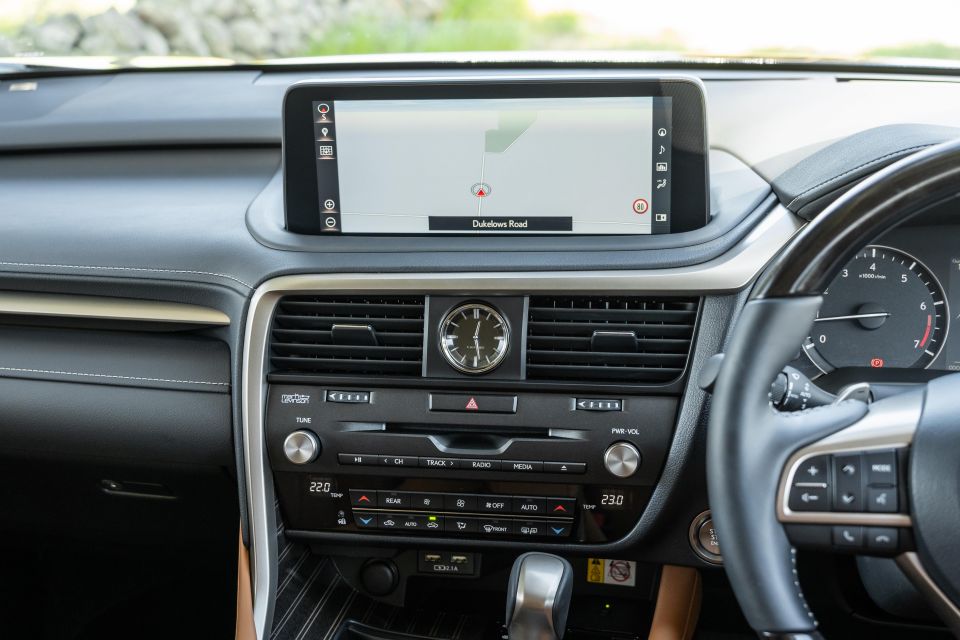
As for infotainment, the facelifted RX range received an updated 12.3-inch touchscreen display across the range with wired Apple CarPlay and Android Auto functionality. The software continues to be a pain point with its fiddly mouse-pad like controller and dated graphics, but it’s a marked improvement on the previous system.
Further, the trackpad makes for a fiddly and inaccurate smartphone mirroring experience when trying to do things on the move, and if you have clumsy fingers like me you’ll probably over scroll or press on the wrong thing which can be frustrating. Luckily, the new touchscreen function means you can go straight to where you want to go or select exactly what you want to select with a prod of the screen itself.
What really shines, however, is the Sports Luxury grade’s 15-speaker Mark Levinson premium audio system. It’s fantastic.
Deep, crisp sound with plenty of adjustment for levels means you can have the RX L’s cabin turn into what sounds like a concert hall. The Mark Levinson system is one of my favourite features in the Lexus catalogue.
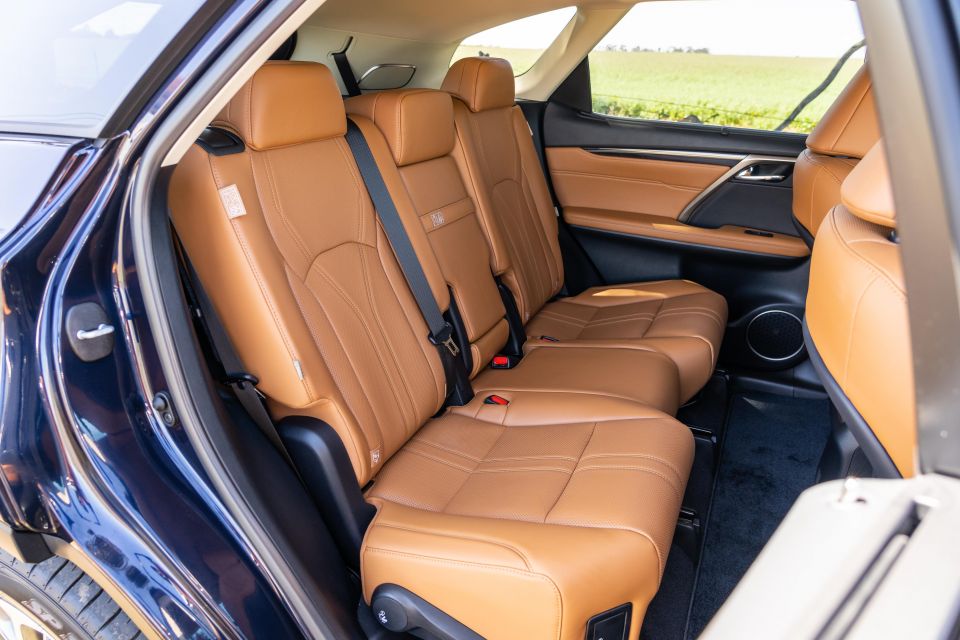
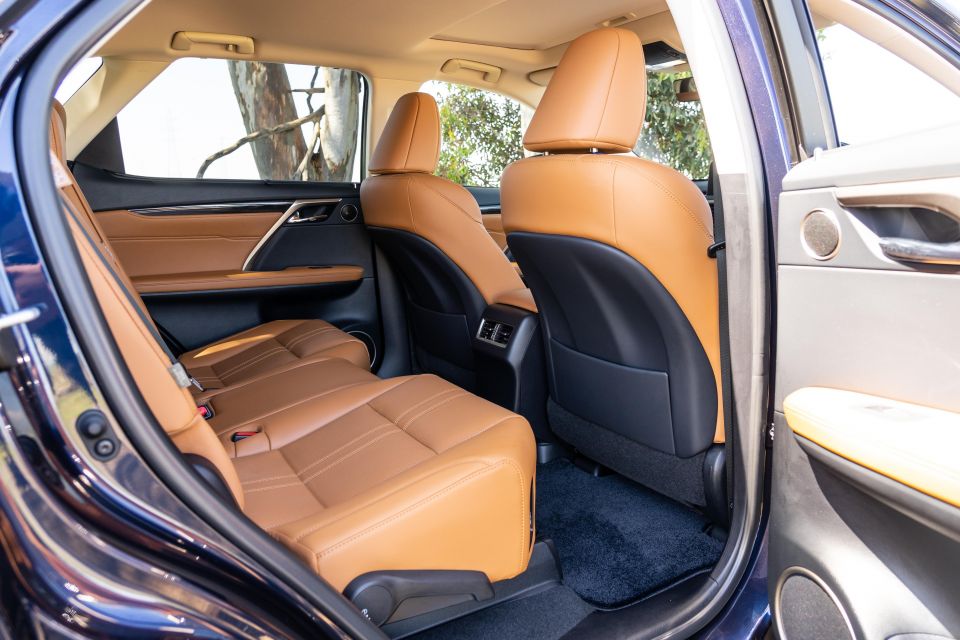
Move to the second row and there’s a sliding and reclining bench that can either maximise comfort for occupants or increase space in the third row/boot area. There’s no third zone of climate control, but there are air vents and airplane style fold-out map pockets behind the front seats.
Further, there are bottle holders in the doors. a fold-down centre armrest with cup holders, ISOFIX child seat mounts on the outboard positions, as well as top-tether points across all three rear seats.
While not quite as limo-like as its long, skinny proportions suggest, the RX L’s second row offers good space for full-sized adults in both head- and legroom, and the outboard positions have supportive under-thigh cushions that offer really good support over longer journeys.
As noted earlier, the rear seats slide fore and aft as well as reclining, allowing for good seat adjustment to maximise comfort, and there are manual sun shades in the rear to block out the haters.
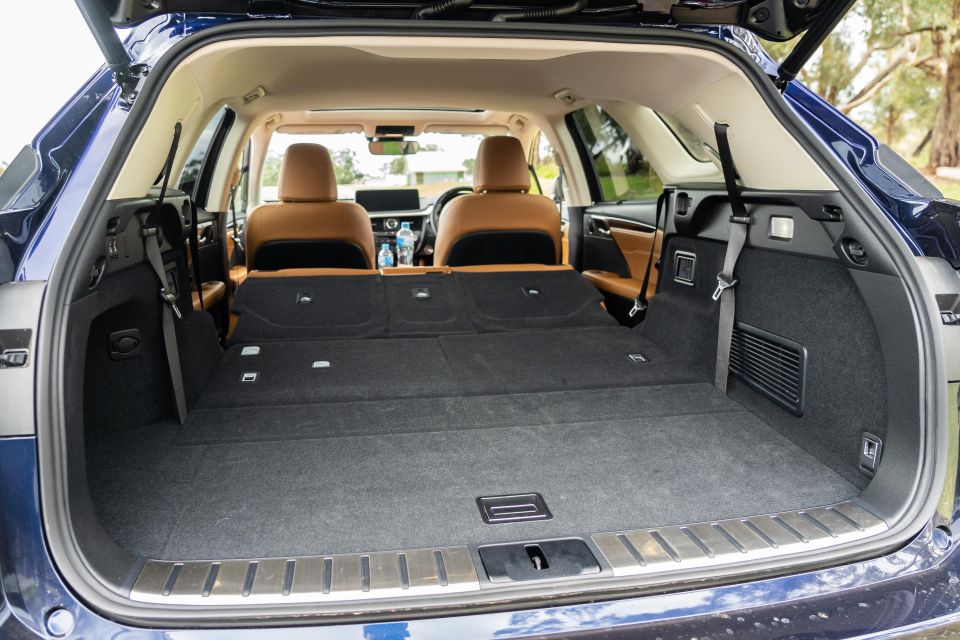
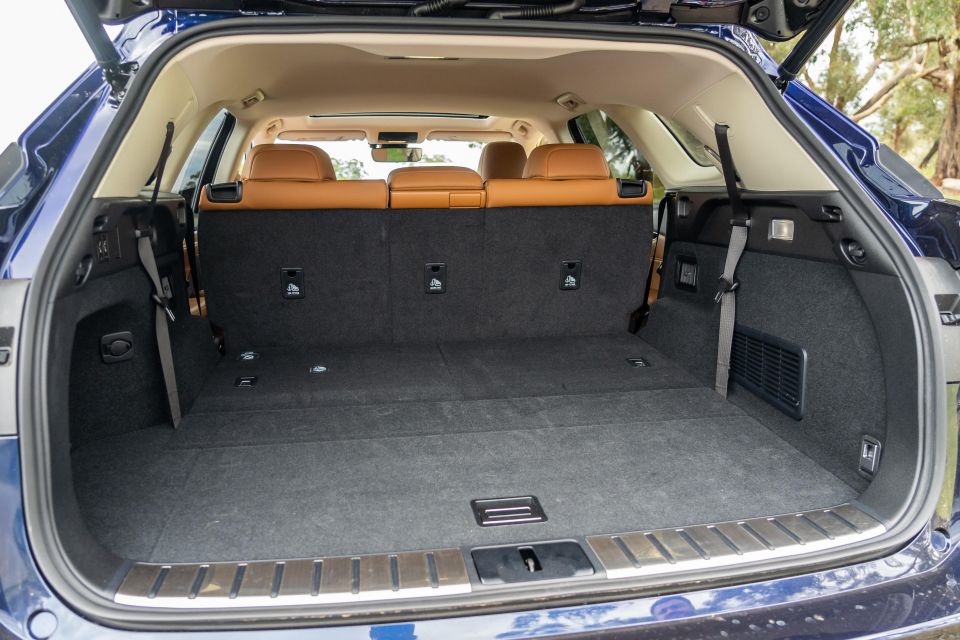
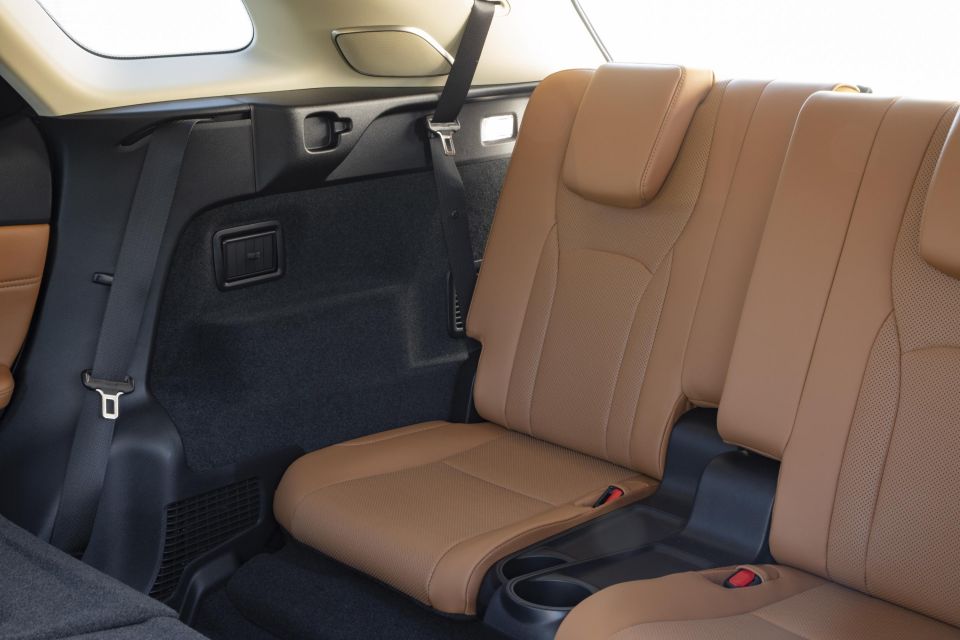
Unfortunately, the third row is next to useless for anyone other than small children, given the limited space for limbs, sloping roofline and flat seats – they do electrically fold out of the floor though, which is a nice little touch.
Kiddies get separate fan controls in the third row, and there’s a cupholder between the two seats.
As for boot space, there’s a teeny 176L (to the top of the seatback) with the third row in place, which expands to 652L (to the roof) with the third row folded into the floor.
There’s also a space-saver spare wheel mounted under the rear of the vehicle, rather than underneath the boot floor.

The RX350 and RX350L are powered by a 3.5-litre naturally-aspirated V6 petrol driving all four wheels via an eight-speed auto.
Five-seat versions develop 221kW (6300rpm) and 370Nm (4600-4700rpm), while the seven-seater has 216kW and 358Nm due to a revised single exhaust system to accommodate the third row of seating.
Lexus claims the RX350L can hit 100km/h from a standstill in 8.2 seconds, and hit a top speed of 200km/h.
Petrol versions of the Lexus RX (RX300, RX350, RX350L) feature a 72L fuel tank, and all models require 95 RON premium unleaded as a minimum.
Claimed fuel consumption is rated at 10.2L/100km on the combined cycle, with CO2 emissions quoted at 234g/km. All RX engine variants are Euro 6 compliant, even though the V6 models don’t get idle stop/start in Australia.
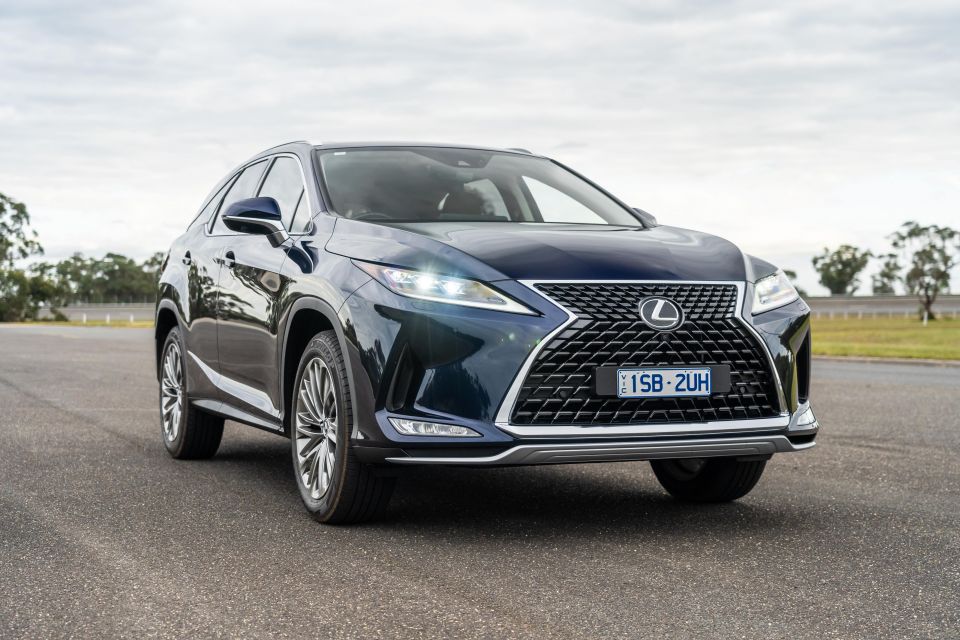
Where most rivals at this price feature diesel engines and mild electrification, the RX350L Sports Luxury has old-school atmo V6 petrol power – whether that’s good or bad is down to your preference.
Like many other aspects of the RX L, the drivetrain and overall drive experience are a bit of a throwback – the clunky gearshift, for example.
Once you’re moving the 3.5-litre petrol V6 is silky smooth, with the eight-speed automatic shifting decisively. There’s good torque down low despite the lack of turbocharging, and acceleration is wonderfully linear. No turbo lag here.
It’s not the punchiest family SUV for the money, with turbocharged rivals from Germany and Korea offering quicker 0-100 times than the 8.2-second claim, but the responsiveness and smoothness of this drivetrain is first-rate.
There’s a decent weight to the steering, and the wood on the wheel matches its somewhat wooden feedback. It is predictable and communicative enough, but this is a relaxing, comfort-focused drive rather than an engaging sports-luxe vibe like the badge might suggest.
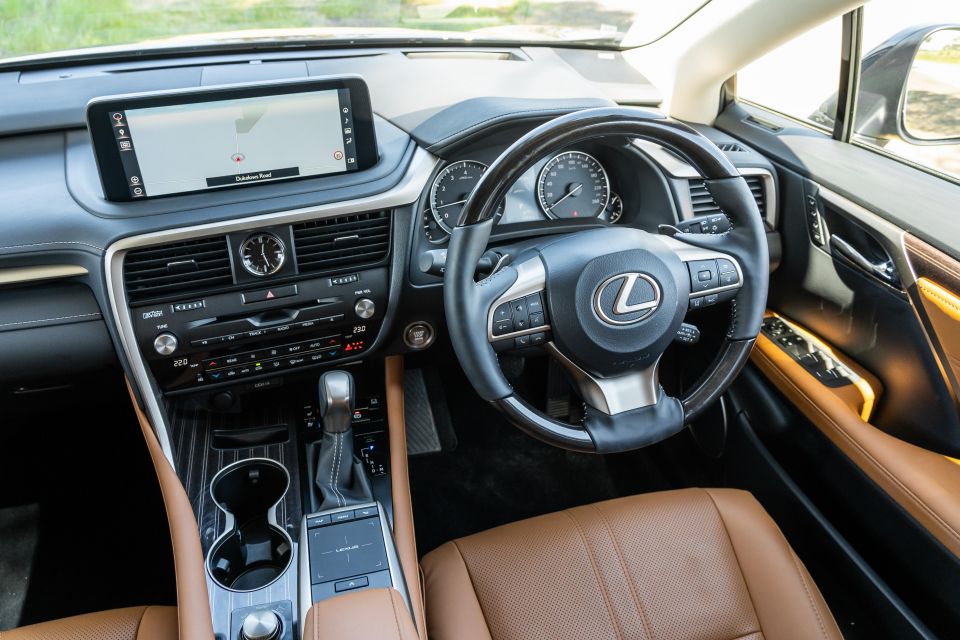
With adaptive variable suspension (or adaptive damping) the RX L rides wonderfully in its standard Comfort setting. Despite the 20-inch alloys and relatively low-profile 235/55 tyres, it manages to iron out pimpled inner-city streets, and keeps ambient noise to an absolute minimum.
The RX L is still one of the most refined vehicles in its class, with minimal noise of any kind penetrating the cabin and the smooth growl of the V6 petrol engine only presenting itself under hard throttle.
To be honest, despite its Japanese heritage the RX L really feels quite American. Soft, smooth, and quite solid.
It’s a similar story when things get a little twisty. The RX L is never going to give a BMW X5 sleepless nights, but it will corner fairly confidently, and keeps body roll to acceptable levels.
Some engineering developments employed as part of a mid-life refresh to improve the drive experience included more body adhesive and weld points to enhance rigidity, and friction control devices on the front and rear shock absorbers to minimise high-frequency vibrations to improve ride comfort.
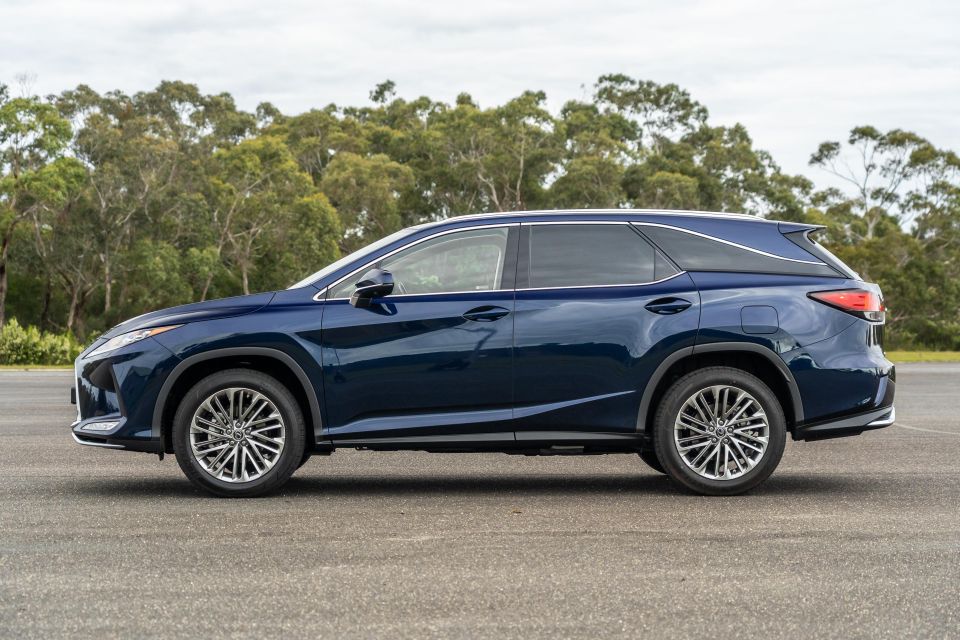
Where expert car reviews meet expert car buying – CarExpert gives you trusted advice, personalised service and real savings on your next new car.
Having driven a pre-facelift RX350L a few years back, the new one feels more resolved and less wallowy, also aided by the revised power steering system and brake-based torque vectoring.
If you want a large luxury SUV that’s going to keep you engaged and perhaps put a smile on your face while tackling some bends, you’d be better served by a BMW X5 or a Volkswagen Touareg R-Line.
The current RX L offers the Lexus Safety System+ suite which includes AEB with pedestrian and cyclist (day) detection, Lane Tracing Assist (active centring), adaptive cruise control with stop/go, and traffic sign recognition.
The adaptive cruise control is a little conservative in that it’ll brake as soon as another vehicle enters your lane ahead – even if it’s beyond the set following distance – and hangs back a bit in its closest setting. Otherwise it’s handy and takes some of the load off long highway stints, and the active lane centring is adequate but not as good or as intuitive as you’ll find from rival brands.
Having blind-spot monitoring and rear cross-traffic assist is also handy given the proportions, as well as the rear pillars and tapered glasshouse, and the surround-view camera system is likewise very helpful for parking this big, luxurious bus.
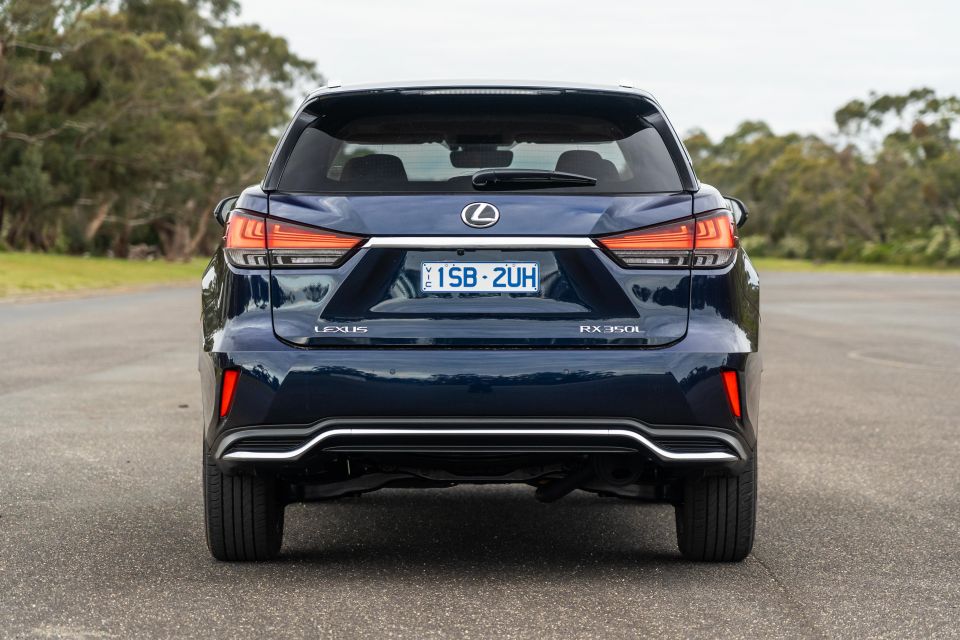
The RX is covered by a four-year/unlimited-kilometre warranty. It’s worth Genesis, Mercedes-Benz, Jaguar Land Rover, and Volvo have moved to longer five-year warranties.
Servicing intervals are a typical 12 months and 15,000km, whichever comes first. Lexus’s servicing is capped at $595 per visit for the first three years or 45,000km.
You also get access to the Lexus Encore ownership program, which gives owners access to Caltex fuel discounts, invitations to luxury dinners and events, as well as luxury hotel partnership benefits.
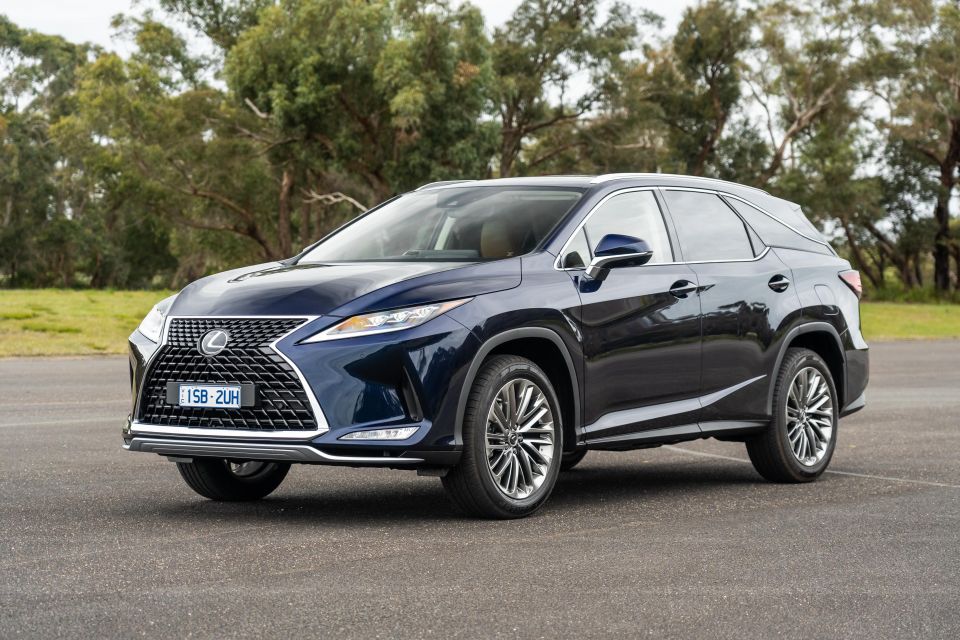
Buy your new car without the stress. It's fast, simple and completely free.

Great service from Travis and team, second time I have used this business would not hesitate to recommend them to anyone
Craig C.
Purchased a Ford Ranger in Sunshine Coast, QLD
CarExpert helped Craig save $7,224 on his Ford Ranger, now let us save you on your next new car.
Get your BEST priceThose wanting a luxurious family SUV with all the trimmings and refinement, plus a solid track record of reliability, could do much worse than an RX350L Sports Luxury.
While it won’t set your pulse racing from behind the wheel, the flagship V6 seven-seater offers everything you could want and then some for the same money as entry-level German rivals requiring a long list of options to match the seemingly never-ending features list.
It’s plush, refined and pretty practical – provided anyone in the third row is a small child or very small adult – and that 3.5-litre V6, while a little old, is beautifully smooth.

Drawbacks? It’s getting old (a new generation should be 12-18 months away), it’s heavy, it’s thirsty, and some of its technology (in typical Toyota/Lexus fashion) feels a step or so off the mark compared to the bulk of the competition.
That’s sort of the point, though. Lexus appeals to lovers of analogue clocks and mobile phones with actual buttons. If you’re not ready for a digitised drive just yet, this could be a fantastic luxury family bus for you.
My tip? Seriously consider the hybrid despite the $9000 premium. If you do the bulk of driving around town (and most owners will), you’ll halve your fuel bill without trying, and reduce your environmental impact. Plus it’s quicker.
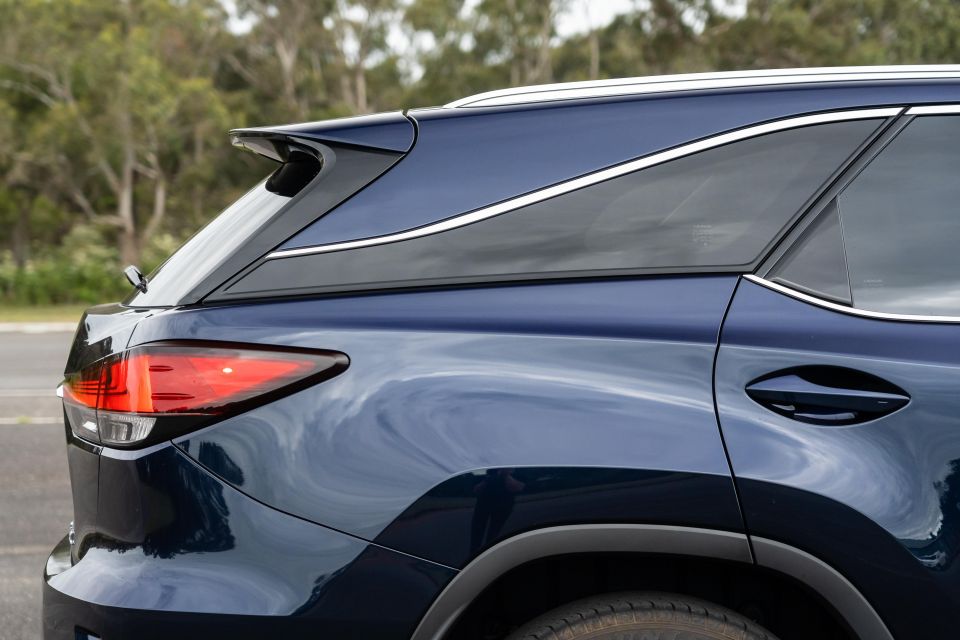
Click the images for the full gallery
MORE: Everything Lexus RX
Where expert car reviews meet expert car buying – CarExpert gives you trusted advice, personalised service and real savings on your next new car.
James Wong is an automotive journalist and former PR consultant, recognised among Australia’s most prolific motoring writers.


William Stopford
2 Days Ago
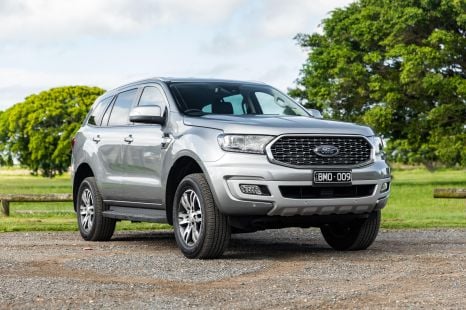

William Stopford
4 Days Ago
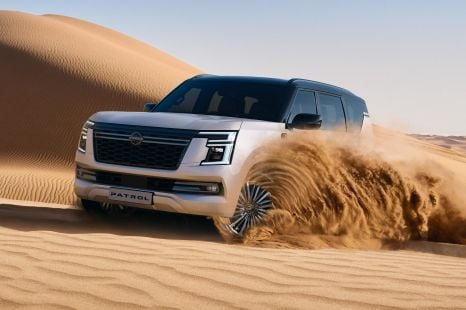

James Wong
7 Days Ago
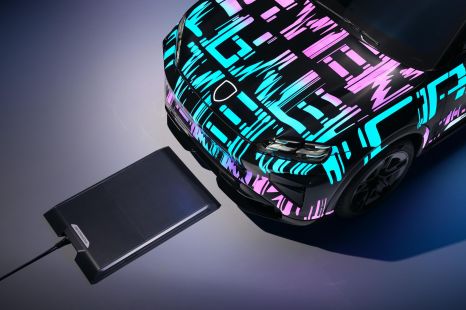

Derek Fung
11 Days Ago
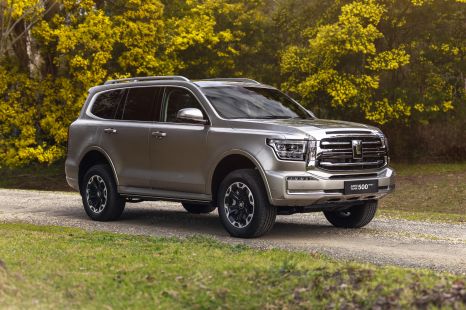

William Stopford
13 Days Ago
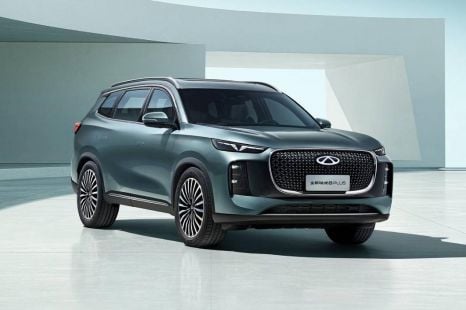

William Stopford
19 Days Ago